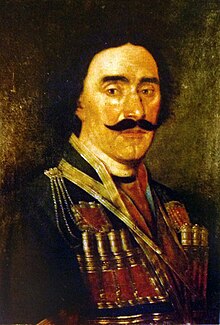| Revision as of 22:54, 7 September 2012 editAnomieBOT (talk | contribs)Bots6,576,814 editsm Dating maintenance tags: {{Expand Georgian}}← Previous edit | Revision as of 10:36, 7 October 2012 edit undoKober (talk | contribs)Autopatrolled, Extended confirmed users, Pending changes reviewers46,985 edits replacing a modern painting (copyvio?) with a 18th-century portraitNext edit → | ||
| Line 1: | Line 1: | ||
| {{Expand Georgian|სოლომონ I|date=September 2012}} | {{Expand Georgian|სოლომონ I|date=September 2012}} | ||
| ] | ] | ||
| '''Solomon I''' ({{lang-ka|სოლომონ I}}) (1735 – April 23, 1784), of the ], was ] (western ]) from 1752 to 1766 and again from 1768 until his death in 1784. | '''Solomon I''' ({{lang-ka|სოლომონ I}}) (1735 – April 23, 1784), of the ], was ] (western ]) from 1752 to 1766 and again from 1768 until his death in 1784. | ||
Revision as of 10:36, 7 October 2012
You can help expand this article with text translated from the corresponding article in Georgian. (September 2012) Click for important translation instructions.
|

Solomon I (Georgian: სოლომონ I) (1735 – April 23, 1784), of the Bagrationi Dynasty, was King of Imereti (western Georgia) from 1752 to 1766 and again from 1768 until his death in 1784.
Solomon was a son of Alexander V of Imereti by his second wife Tamar née Abashidze and succeeded upon his father's death in 1752. He immediately launched a series of stringent measures against the renegade nobles and slave trade from which they profited in conjunction with the Ottoman authorities. In 1752, the aristocratic opposition staged a coup, but Solomon quickly regain the crown and began a program of reforms aimed at stabilizing the kingdom torn apart by chronic civil wars. The Ottomans, which saw Imereti as the sphere of their influence, sent in an army, but Solomon succeeded in mobilizing his nobles around him and defeated the invaders at the Battle of Khresili in 1757. The same year, he forged an alliance with his kinsman, Heraclius II, who ruled in eastern Georgia. The Ottoman raid continued into the 1760s until they drove Solomon from his capital at Kutaisi in 1765 and placed his cousin, Teimuraz on the throne. In 1768, Solomon managed to stage a comeback, but his kingdom remained occupied by the Turks. The same year, another Russo-Turkish broke out, and in May 1769, Solomon traveled to Tbilisi to meet with Heraclius II. The two kings decided to request five Russian regiments and join the war with the Ottoman Empire in exchange of the guarantee that Georgian interests would be protected in the final Russo-Turkish peace deal. The Russians sent a small force under General Gottlieb Heinrich Totleben who helped Solomon to recover Kutaisi in August 1770, but the general's rudeness and condescension alienated the Georgians; Totleben was quickly recalled from Georgia, but his successor failed to take the Ottoman-held Georgian port of Poti on the Black Sea. After the war was over, Solomon was able to force his autonomist vassals, princes of Mingrelia and Guria, into submission, and continued antagonizing the Ottoman hegemony in the region. Having crushed the Ottoman-sponsored invasion from Abkhazia in 1779, he made a series of forays into the Turkish-controlled southwestern Georgian lands. He died in March 1784 and was buried at the Gelati Monastery.
He was married three times; first, to Princess Tinatin Shervashidze, second to Princess Mariam Dadiani and third, Princess Gulkan Tsulukidze. He had three children, one son and two daughters:
- Prince Alexander (1760–1780)
- Princess Darejan (1756–1827); married, in 1768, Prince Kaikhosro Abashidze
- Princess Mariam (1769–1845); married Prince Elizbar Eristavi of Ksani (1738–1813)
References
- Suny, Ronald Grigor (1994), The Making of the Georgian Nation: 2nd edition, pp. 57-8. Indiana University Press, ISBN 0-253-20915-3
- Template:Ge icon სოლომონ I (Solomon I). People.Istoria.Ge. Accessed on September 23, 2007.
| Preceded byAlexander V | King of Imereti 1752-1766 |
Succeeded byTeimuraz |
| Preceded byTeimuraz | King of Imereti 1768-1782 |
Succeeded byDavid II |